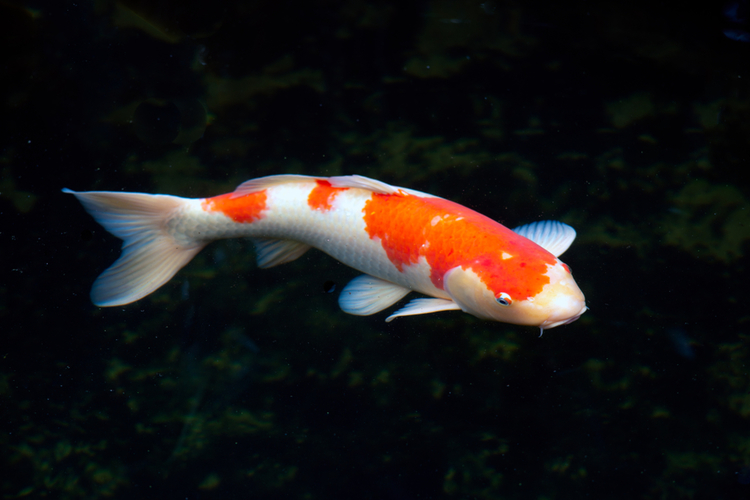Japanese Nishikigoi Fish: “Swimming Jewel”
Japanese Nishikigoi (Nishiki-koi) fish is classified into over 100 variations.
With its beautiful colorful patterns, it is called "swimming jewel" or "the world's largest garden fish" that is gaining more and more Nishikigoi fans around the world.
As the information on Japanese Nishikigoi constantly released through the Internet and SNS, many Nishikigoi fans and tourists from all over the world come over to Nagaoka city, Niigata where Nishikigoi originated.

What is Nishikigoi Fish?
Nishikigoi is a generic term for breed improved carp for ornamental purpose.
The origin of Nishikigoi comes from multi-colored brocade patterns of kimono, known for its vivid and beautiful colors.
On the other hand, black Koi fish called carp in English is freshwater fish inhabiting the natural ponds in different regions across Japan.
Japanese Nishikigoi is called "Asian Carp", "a (vari) Colored Carp" in English, but recently it has been recognized as “Koi” or “Nishiki Koi” or “Koi Fish.”
The total length of Nishikigoi is ranging from 10 cm for small types to over 1 m for large types that you can choose a location and amount of water to keep it depending on the size of Nishikigoi.
These days, without having a large pond in the yard, you can keep small Nishikigoi in your apartment house or indoor as long as you have a space for a fish tank.
Birth of Nishikigoi Fish
The birth of Nishikigoi goes back to approx. 200 years ago in Edo period.
A farmer in Nagaoka City (former Yamakoshi-mura) in Niigata found a carp with beautiful patterns and colors by mutation in a pond located on the upper level of terraced rice-fields.
This was the beginning of Nishikigoi for ornamental purpose.
After that, "mutation koi" was exhibited at "Tokyo Taisho Expo" held in 1914 during Taisho period and became known all over the country.
Particularly, Koi fish with red and white colors attracted attentions because it reminded people of the flag of Japan, and it soon became known in the world as well.
At the time, this "mutation carp" was called "Hana-koi (flower carp)" and "Iro-koi (colorful carp)" and then started to be called "Nishikigoi" since the end of the World War Ⅱ.
In addition, Nishikigoi was nicknamed "national fish" at the 1st National Nishikigoi Conventional Fair held in 1968.
The Four Reasons for Why Nishikigoi has so Many Fans around the World

T he Four Reasons of Nishiki-koi Attraction
There are four main reasons that overseas fans love Nishikigoi.
First of all, overseas fans find so-called “Wabi-sabi atmosphere (Japanese exoticness)” in
Nishikigoi that most domestic people do not really recognize.
Also, the way Nishikigoi swims in the pond gives a sense of gracefulness and elegance that overseas fans call it "swimming jewelry".
Secondly, Nishikigoi’s friendliness makes them feel emotionally close just like having pets.
Furthermore, just because every Nishikigoi is unique in terms of body shape, colors and
patterns, or skin texture unlike other fish that Nishikigoi fans cherish the sense of “only one in the world.”
Thirdly, overseas fans perceive Japan’s “beauty of nature and vivid colors" in the patterns and colors of Nishikigoi just like “swimming jewel.”
Lastly, watching the elegant swimming movements of Nishikigoi makes you feel relaxed and smile.
Different Nationalities, Different Taste
Among a wide range of variations of Nishiki-koi, preference varies depending on people’s background such as as nationality, regions, or ethnicity.
For example, the top five color patterns loved by Japanese fans are:
·"Red and white"
·"White-out"
·"Five colors"
·"Taisho three colors"
·"Showa three colors"
In particular, Nishikigoi with black color in the traditional color patterns of "red and white," and white background with some nice patterns are especially popular among Japanese.
Some foreign fans like these variations as well, while many other foreign fans like unique variations.
For example, Nishikigoi variations liked by western fans are "solid glowing color" which is a pattern with gold color in solid background color, and "Kawari-koi (unique colors and patterns" in dim background color.
Many of western fans treat Nishikigoi as "pets", rather than ornamental purposes.
Also, red is an auspicious color in China, so their favorite types of Nishikigoi that contains beautiful red and gold colors.

Higher Demand in Overseas Markets
A pprox. 80% of Nishikigoi bred in Japan is exported
Approximately 80% of Nishikigoi bred in Japan is exported to overseas due to its much higher demand than that of domestic.
This is due to the unfavorable housing conditions in Japan to keep Nishikigoi and the growing number of affluent population supported by the rapid economic growths of Asian countries.
Changes in Japan’s housing environment have contributed to lower domestic demand.
Domestic demand for Nishikigoi is on the decline due to the decreasing number of houses with ponds in the large gardens where they can afford to have Nishikigoi, while more high-rise condominiums and apartment buildings have been built.
On the other hand, the demand for Nishikigoi in overseas markets has increased with a greater number of westerner fans as well as higher demand in Asian countries such as Hong Kong, China and Southeast Asia.
In particular, Nishikigoi is popular as a “lucky charm” among Chinese people who wish for business prosperity and successful career.
For these reasons, the demand among affluent population in Asian countries has been on the rise.
P romising Overseas Markets
Today, Nishiki-koi is bred not limited in Japan, thus overseas buyers and fans can purchase from any Nishikigoi breeders around the world.
However, Japan-origin Nishikigoi is still popular among overseas buyers and fans.
For that reason, many overseas buyers and fans with media-related people come to visit local Nishikigoi farms and fairs in Japan in order to directly purchase.
The countries in which many fans of Japan-origin Nishikigoi live are: USA, Belgium, UK, the Netherlands, Germany, China, Hong Kong, Singapore, Taiwan, Indonesia, the Philippines, etc.
When more Nishikigoi fans and tourists from these countries come to visit Nishikigoi
farms in Japan, the excellence of Japan-origin is expected to be recognized through in-person communications between Japanese breeders so high reputations would be spread out through word mouth.
This would give more opportunities to expand the oversea markets for Japan-origin Nishikigoi.
Despite the fact that Nishikigoi is bred overseas as well, Japan-origin Nishikigoi can be
considered premium brands and stay competitive in overseas markets.
Conclusion
Japan-origin Nishikigoi, loved by both overseas fans and foreign tourists, is admired as "swimming jewel" in Japanese culture.
Taking this opportunity, why don’t you visit a Japanese garden with pond(s) and enjoy watching beautiful Nishikigoi?









